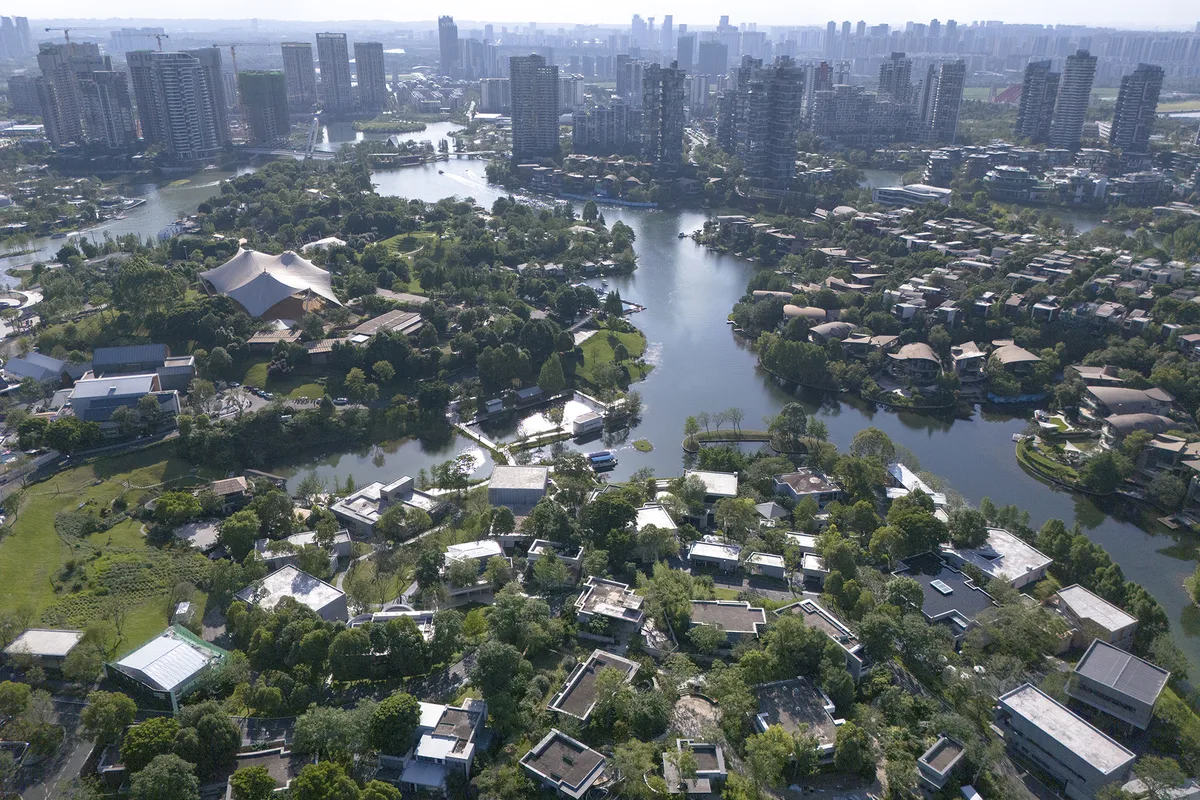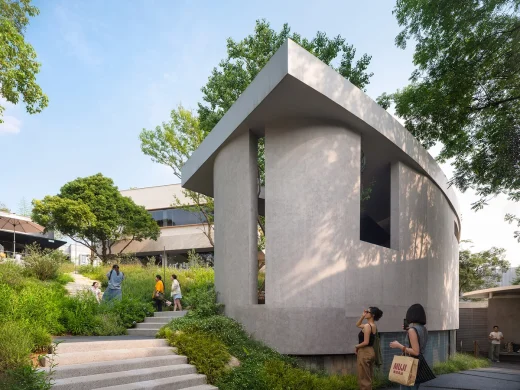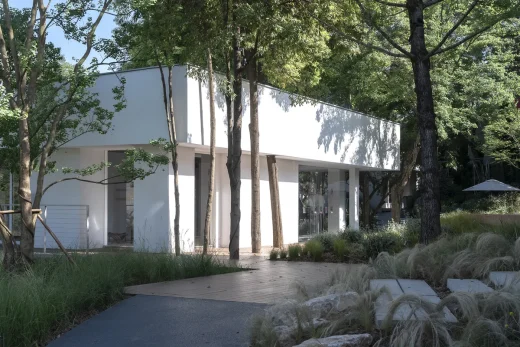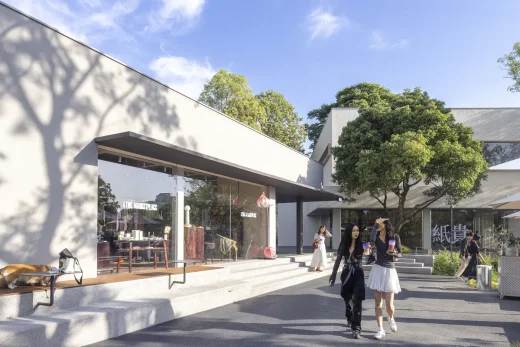Luxe Lakes CPI Island, Masterplan, Commercial Renewal Project, Chengdu building complex, People’s Republic of China architecture images
Luxe Lakes CPI Island in Chengdu
11 September 2024
Architecture: Cheng Chung Design
Location: Chengdu, People’s Republic of China
Photos by Photography: Existing Architecture, Blue Orange Photography
Luxe Lakes CPI Island, China
Luxe Lakes CPI Island: The Average Temperature and Subtle Scenery Between Islands
The Luxe Lakes CPI Island Commercial Renewal Project is a collection of villa models located on the east side of Luke Island in the “Luxe Lakes Ecological City” of Chengdu. More than 20 former Luxe Lakes Villa models have been located on the island. CPI Island needs a revitalized urban renewal and commercial iteration to reset the idle old properties on these islands, activate the connection between waterfront, human habitation, and commerce.
Through a series of systematic planning and design, vari architects renovated and expanded ten existing buildings, and designed and built ten new buildings based on the terrain, reconstructing the axis system and spatial relationships of the original site – paying tribute to the past with a new life.
01 DESIGN CONCEPT
During the design process, two concepts – “Average Temperature” and “Subtle Scenery” defined by Japanese philosopher Washida Kiyokazu, are very inspiring to us. Average Temperature signifies the typical or ordinary state of things in a city, capturing the essence or the norm of the city’s atmosphere, culture, or mood.
From this point of view, there is probably no better setting than Chengdu’s to shape a space imbued with a sense of relaxation. So naturally, the design of CPI project lays its emphasis on how to create a space of average temperature specific to Chengdu through a series of spatial strategies, highlighting its urbanistic character and norm of coziness and comfortableness, which Chengdu locals often refer to as “Chill”.
02 BUILDING DESIGN APPROACH
After completing the holistic design, vari architects continued to pursue “Average Temperature” at the architectural scale and focused on exploring the concept of “subtle scenery.” Subtle scenery, or “subtle landscapes,” refers to those delicate and often overlooked aspects of our sensory experiences and surroundings.
In design tactics, firstly, vari architects made full use of the micro-topography to create terraces and split-level spaces. This not only allows the architecture to harmonize with nature but also creates appropriate visual screens, resulting in layered spatial transparency.
Secondly, vari architects focused on the use of “gray spaces/semi-open space”. By incorporating cantilever designs, vari architects maximized the integration of Luxe Lakes Eco-Island’s natural ecology into the architectural space, blending people, buildings, and nature into a serene landscape; at the same time, the stepped terraces design fosters urban social spaces. Together, these elements create spaces that are both everyday and ceremonious.
Thirdly, vari architects adopted simple and effective forms to soften the architectural presence, making it approachable and even charming. Fourthly, they emphasized a unified color palette for the facade, using shades of gray and white. This was achieved through a diverse expression of materials such as concrete, paint, glass, and metal.
03 HOLISTIC DESIGN APPROACH
Vari architects reconstructs CPI Island through three key “update” actions: The placement of spatial nodes; Renovation and construction of individual buildings.
Placement of node space
Secondly, vari architects embedded six small squares as core natural social spaces within the framework, creating friendly social areas and developing spatial nodes around them.
Building Renovation and New Construction
Thirdly, based on these nodes, we established six different groups, vari architects make precise insertion of new buildings and the proper alteration of the existing buildings, which as a result transforms the form of CPI from a dispersed field of singular typology into a “collective form” of varied morphologies that incorporate both centrality-oriented and semi-open clusters.
This two-step systematic design action creates a spatial network on CPI island for visitors to wander and linger as well as to explore and enjoy, echoing/highlighting the Genius-loci of Chengdu city.
04 DESIGN DETAILS
Among all vari architects designed buildings, there are 10 newly built buildings and 10 renovated buildings.
Node 1 Visitor Center Group
Include W01 (renovated) W01-1 (new-built)
Add a second floor between W01 and the newly built W01-1 at the entrance, creating a very welcoming entrance square. The first floor of the building is fully open to the public, making the entire space rich and relaxed.
Node 2 Refreshment Group
Include W02(renovated) W03(renovated) W05(renovated)
W02 and W03 respectively use upward and horizontal growth design techniques to increase the continuity of the building, forming a completed lakeside landscape. W05 integrates the facade with a simple technique, using clear water textured paint paired with colorful steel columns to further highlight the geometric composition of this building.
Node 3 Pop-up Store Group
Include W06 (new-built) W07 (new-built) W08 (new-built) W21 (new-built)
The newly built Pop-up group, guided and restricted, has transformed the originally spacious and open space into the most interesting part of the entire project, providing a rich spatial experience and playing an important role as the intersection square of the triple transportation axis.
Node 4 Communal Group
Include W19 (new-built) W24 (new-built) W25 (renovated) W20-1 (new-built) W20-2 (new-built)
Through the obstruction of the W20-1 radio station and the W19 curved gallery, the space in the two areas is connected by a narrow landscape road. This curved walkway itself provides a richer spatial experience, and several interesting small buildings form a living community group.
Node 5 Design&Culture Group
Include W09 (renovated) W10 (renovated) W11 bookstore (renovated) W11 exhibition hall2(new-built)
The original building of W11 has been transformed into a bookstore, with an additional exhibition hall located in the center of the entire project. The first floor is elevated, and opposite the pier is another main entrance to the entire site. The elevated layer can host small events, activating the connection between human habitation and waterfront.
Vari architects adopts a humble and restrained approach, focusing on highlighting the spirit of place characterized by a sense of calmness and relaxation. By integrating the existing architectural structures and topographical features, it aims to achieve a design pursuit of average temperatured subtle sceneries. Through this approach, the project explores and showcases the evolving yet enduring essence of Chengdu’s urbanistic character.
Luxe Lakes CPI Island in Chengdu, China – Building Information
Architectural Design: vari architects – http://variarchitects.com/about_vari_architects/
Project location: Chengdu, Sichuan Province, China
Project time: 2022.10 – 2024.4
Owner: Chengdu Wide Horizon Real Estate Development Co., Ltd.
Owner Design Management (Architecture):
Chengdu Luhu Cultural Tourism Development Co., Ltd.: Xi Luo, Xinyin Liang, Guoqin Li, Chuanxi Zhu
Chengdu Wide Horizon New City Investment and Development Co., Ltd.: Jiuxu Bai,Kaiwen Wang
Building area: 7000 square meters
Contact e-mail:[email protected]
Lead architects: Fan Qi, Dingliang Yang
Project architects: Panao Feng, Chenxin Wang, Handan Tang, Xiaoyu Ding, Mou, Jun Li
Construction unit: Tutai Construction Group, Dingyu Construction Engineering Co., Ltd
Construction drawing design: Zhoyu Design Group Co., Ltd.;Sichuan Zhonghengzhuke Survey and Design Co., Ltd.
Landscape Design: Yudao Landscape
Lighting Design: BPI Lighting Consultant Design Company
Curtain wall deepening design: Zhoyu Design Group Co., Ltd.
Photography: Existing Architecture, Blue Orange Photography
Copywriting: Fan Qi, Dingliang Yang, Chenxin Wang
Luxe Lakes CPI Island, People’s Republic of China images / information received 110924
Location: Wuhan, China
New Wuhan Architecture
Sunac · Wuhan 1890 Buildings
Sunac · Wuhan 1890, No. 170, Qintai Avenue, Wuhan City
Design: Lacime Architects

photo : Inter_mountain
Wuhan SUNAC 1890, Hanyang District
Contemporary Buildings in Wuhan, China
Sino-Ocean Sales Center in Wuhan
Design: Waterfrom Design

photograph : Yuchen Chao
Sino-Ocean Sales Center Wuhan
Light Waterfall Design
Architects: Kris Lin International Design

image courtesy of architects practice
Light Waterfall Wuhan
Huafa & City Hub
Architect: Qin Yue-Ming

photograph : JING Xu-Feng
Huafa & City Hub in Wuhan
Wuhan Creative Design Center Building
Wuhan Greenland Center Apartment
Greenland Optics Valley Center Wuhan
SCP Wuhan Qingshan InCity Master Plan
New Chinese Architecture
Contemporary Buildings in China
Shanghai Yangtze River Delta G60 Innovation Center, Shanghai

image courtesy of architects practice
Shanghai Yangtze River Delta G60 Innovation Center
Tiantou Intelligent Harbour Concept, Chengdu
Design: Aedas with China Southwest Architectural Design and Research Institute

image courtesy of architects practice
Chengdu Tiantou Intelligent Harbour Project
Tower C at Shenzhen Bay Super Headquarters Base, Shenzhen
Design: Zaha Hadid Architects (ZHA)

image courtesy of architectural office
Tower C at Shenzhen Bay
Comments / photos for the Luxe Lakes CPI Island, Chengdu designed by vari architects page welcome





















